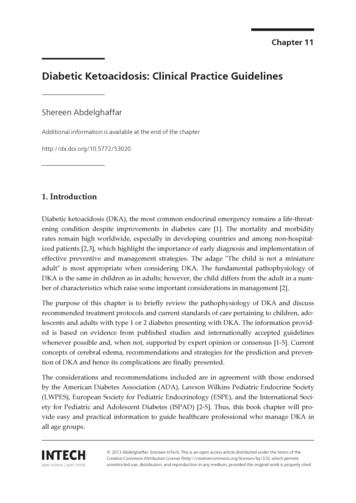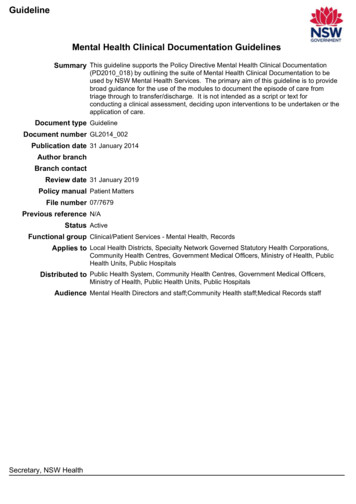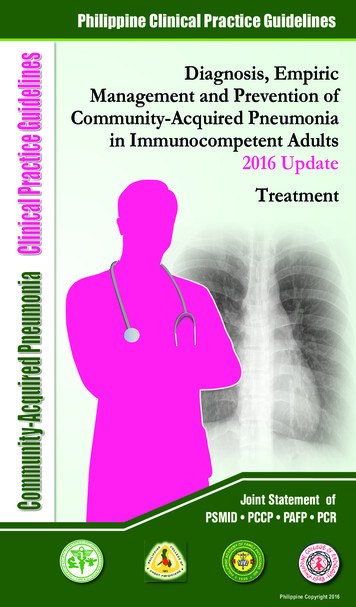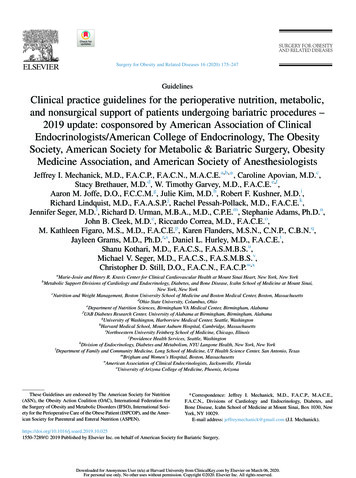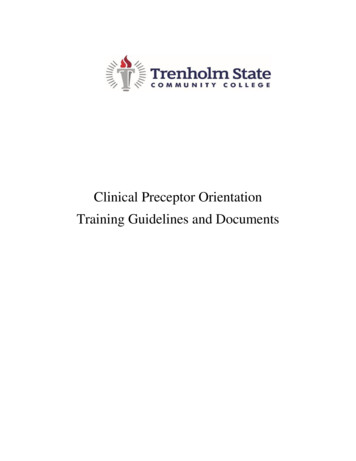
Transcription
Clinical Preceptor OrientationTraining Guidelines and Documents
Table of ContentsTrenholm State EMS Program Contact InformationClinical Preceptor RequirementsPurposes of student rotation (minimum competencies, skills, and behaviors)Team Lead PreceptorshipCoaching and mentorship techniquesCriteria of evaluation for grading students and Evaluation FormsDefinition of Team LeadsRequired minimum number of Team LeadsAPPENEDIX ASkills students are allowed to do in Clinical settingAPPENEDIX BPreceptor Responsibilities, Mentoring techniquesAPPENEDIX CSkills competencies and patient contact requirementsFORMS SectionoooooooooooClinical Preceptor AgreementPreceptor Training FormClinical Training Roster FormStudent Progress Report FormTeam Lead Evaluation FormTeam Member Evaluation FormParamedic Clinical (P-2) Evaluation FormAdvanced EMT Evaluation FormEMT Basic Evaluation FormPatient Care Report Form (PCR)Accident / Incident Report Form
Trenholm State EMS Program Contact InformationProgram Director: Danny Perry, MSN, CRNP, RN, NRPOffice Phone: 334-420-4323Email: dperry@trenholmstate.eduClinical Coordinator: Winston Warr, ASN, RN, NRPOffice Phone: 334-420-4433 Cell Phone: 334-391-6365Email: wwarr@trenholmstate.eduClinical Instructor: Ryan Moore, BS, ASN, AAT, RN, NRP, FP-COffice Phone: 334-420-4423Email: rmoore@trenholmstate.edu
Clinical Preceptor RequirementsClinical Preceptors are expected to have current certifications as required by the State ofAlabama to practice at the paramedic or RN. They are expected to be professional andcompassionate. To give direction to the students, and assist the student in their learningprocesses. Allow time to discuss the student’s weaknesses as well as their strengths. Providefeedback and discuss areas that need improvement. The clinical preceptor will have a majorimpact in the overall outcome of the student as a paramedic and the quality of care theyprovide. Licensed in the State of Alabama as a Paramedic or Registered Nurse (RN)Have a minimum of Two (2) years’ experience as EMTP or RN.Hold current certification in ACLS, PALS, ITLS / PHTLS or TNCC.Must be approved to serve as a preceptor by your employer and TrenholmState EMS program.Demonstrate a willingness and competence to work with students to assistthem in meeting pertinent course objectives in clinical and / or field setting.Supervise, regulate, and document accurately, student behavior in theclinical and/ or field setting.Complete the student clinical evaluations sheet at the end of the shift.Please be honest in evaluating the student. If you feel that student is notperforming at their level of training, please indicate this in your clinicalevaluation. I read each clinical evaluation and take the preceptor commentsvery seriously.Assure that all student-performed clinical procedures are supervised.Provide the Clinical Coordinator with your work schedule upon request.Inform the Clinical Coordinator of any changes in your work schedule thatmight affect your ability to oversee EMS students performing clinicalrotations.
Purposes of student rotation (minimum competencies, skills, and behaviors)The purpose of student rotations is directed toward the application of knowledge and skillsdeveloped in didactic and skills laboratory experiences to the clinical setting. Theory and skillsare applied to a variety of patient situations in the Clinical and Field setting. The importantpoint is that students have the opportunity to interact with a variety of patients who areexperiencing a range of illnesses and injuries throughout the various age groups.Minimum Competencies : Demonstrate the ability to comprehend, apply, and evaluate theclinical information relative to his/her role as an entry level EMT, Advanced EMT, or Paramediclevel. Competencies are established by the program advisory committee and are reviewedperiodically as needed. See Appendix C for the required minimal competencies.Skills : Demonstrate technical proficiency in all skills necessary to fulfill the role as an entrylevel EMT, Advanced EMT, or Paramedic level. See Appendix A for list of skills allowed for eachlevelBehaviors: Demonstrate personal behaviors consistent with professional and employer’sexpectations for the entry level Basic, Advanced EMT, or Paramedic level. Professional Behavior (Affect): Students demonstrates they are:o Self-motivated: Takes initiative to complete assignments, and improve/correctproblems, strives for excellence, incorporates feedback, and adjustsbehavior/performance.o Efficient : Keeps assessment and treatment times to a minimum, releases otherpersonnel when not needed, organizes team to work faster/better.o Flexible : Makes adjustments to communication style, directs team members,changes impressions based on findings.o Careful : Pays attention to detail of skills, documentation, patient comfort, setup and clean up, completes tasks thoroughly.o Confident : Makes decisions, trust and excercises good judgement, is aware oflimitations and strengths.o Open to Feedback : Listes to preceptor and accepts constructive feedbackwithout being defensive (interrupting, giving excuses).
TEAM LEADER PRECEPTORSHIPThe team leader position is when the student demonstrates that he/she is fully capable oforganizing and directing patient care on an EMS call. The Team Leader, depending on thenumber of ALS EMS personnel present, should ideally not provide any direct patient care orinterventions, but rather should direct all team members and lead all patient care decisions.When the student serves as Team Leader, every call must be evaluated.Team Leadership Objective: The student has successfully led the team if he/she has conducteda comprehensive assessment (not necessarily performed the entire interview or physical exam,but rather been in charge of the assessments), as well as formulated and implemented atreatment plan for the patient. This means that most (if not all) of the decisions have beenmade by the student, especially formulating a field impression, directing the treatment,determining patient acuity, disposition and, if applicable, packaging/ moving the patient.Minimal to no prompting was needed by preceptor. No action was initiated/performed thatendangered the physical or psychological safety of the patient, bystanders, other responders orcrew. (Preceptors should not agree to a “successful” rating unless it is truly deserved. As ageneral rule, more unsuccessful attempts indicate willingness to try and are better than noattempt at all.)Required Number of Team Leads: 20 ALS Leads35 TotalDefinitions:ALS contact: Patient condition or complaint requires assessment or interventions by anAdvanced Life Support provider. This includes, but not limited to, medication administration,ECG monitoring and establishment of intravenous access.BLS contact: Patient condition or compliant requires assessment or interventions that an EMTshould be able to perform.
Criteria of Evaluation for grading students and Evaluation FormsTrenholm State EMS Program uses the same evaluation form for each level of EMT training,except for the Team Leader Role. A copy of each Evaluation form is located in the Forms SectionDirections on how to complete the evaluation form:Team Member: The student shall complete the form prior to giving to preceptor forapproval, grading and signature. Grading is on a 1 to 5 scale. 5 being experienced and 1 beingunsatisfactory.Team Leader: The student shall complete the form prior to giving to preceptor forapproval, grading and signature. Grading is on a 1 to 5 scale. 5 being experienced and 1 beingunsatisfactory. The preceptor should rate the student in the preceptor column, and commenton any discrepancies in the area of performance section or on the back of the form. Completethe student strengths/weaknesses area and a plan for improvement. The student is alsorequired to complete a patient care report form (PCR) on one of the calls. All other calls arecompleted in FISDAP. The preceptor should review the student’s documentation skills, andprovide suggestions for improvement (if needed).
APPENDIX AWhat Paramedic Students are Allowed to Do During Clinical ActivitiesProvide care for patients experiencing various medical and traumatic conditions andemergencies, to include the following skills. Same as Advanced EMT plus the following:o ECG Interpretation (3 Lead and 12 Lead)o Synchronous and Asynchronous Defibrillationo Transcutaneous Pacingo Endotracheal Intubationo Needle Chest Decompressiono ALS Team Leadership RoleWhat Advanced EMT Students are Allowed to Do During Clinical ActivitiesProvide care for patients experiencing various medical and traumatic conditions andemergencies, to include the following skills. Same as EMT plus the following:o Capnography / EtCO2 Deviceso CPAPo Intravenous Therapy / Peripheral Venous Cannulationo Intraosseous Initiationo Medication Administration Intravenous Intraosseous Intramuscular Subcutaneous Nebulized Sublingual Intranasalo Resuscitationo Airway Management Blind airway insertion Devices (LMA, King, etc.) Artificial Ventilation DevicesWhat EMT BASIC Students are Allowed to Do During Clinical Activities
Provide care for patients experiencing various medical and traumatic conditions andemergencies, to include the following skills. Scene Size UpTrauma Patient Assessment and managementMedical Patient Assessment and managementSpecial Populations Patient Assessment and managementAssist Patients with Medication AdministrationResuscitationDocumentationNormal and Abnormal OB DeliveryCommunication (Radio and Face-to-Face)Clinical Decision MakingAcquiring 12 Lead ECGAirway Managemento Assuring Patent Airway (use of Oral and Nasal Airways)GlucometerOxygen DeliveryPulse OximetrySpinal ImmobilizationTriageVentilatory Management (Use of BVM)Obtain Vital SignsCPAP
APPENDIX BPreceptor ResponsibilitiesThe Paramedic Preceptor is responsible for the direct supervision and evaluation of thestudent. The Field Preceptor will directly supervise the actions and activities of the student atall times during patient care. Supervision and evaluation shall include the following:1. All Skills noted in Appendix A2. Orient the student to agency equipment and supplies (including operation)3. Serve as a teacher, tutor, mentor, and role model4. Be knowledgeable of content matter5. Ensure student provides safe patient care6. Maintain high level of professionalism and ensure professional behavior by student7. Model expected behavior8. Motivate and inspire student success9. Provide student with constructive and timely feedback in a respectful manner10. Create a positive learning environment11. Ensure high level of integrity (if the student does not demonstrate competencies,document deficiencies)12. Complete student evaluation forms prior to student’s departure13. Communicate frequently with program’s clinical coordinator, and if needed, programdirector and/ or program’s medical director14. Counsel in the positive. In discussions with student, tell them:a. What went wellb. What needs revisionc. How to fix the skill or behaviord. Be the advocate for your studente. Be the intermediary between your student and other practitionersf. Praise in publicg. Critique in privateh. Maintain confidentiality for all studentsDuring Team Leadership, in addition to the above, the Preceptor should allow the following:Allow student to assume role of Lead Paramedic, which includes overall scenemanagement, patient assessment, treatment, transport decisions, radio communications, anddocumentation. Preceptor should intervene only when required to ensure patient safety.
APPENDIX CEMT StudentsPatient assessments (primary and rapid/focused), including the documentation of findingsOxygen administrationSpinal immobilizationControl hemorrhageApply splintsAEMT Students48 Hours Ambulance20542296 Hours(48 Hrs-Field/48 Hrs-ER)Comprehensive patient assessmentsAdultGeriatricPediatric (Pediatric patients consist of Newborn, Infant, Preschooler, School age, andAdolescent)Trauma pt.’sAMSChest l painAssess pediatric respirationsMedication AdministrationsSuccessful IV sticksAirway management2515101055555555151515
Paramedic StudentsCLINICAL SECTIONP-2P-3Clinical section:180 hoursField / TeamLeader: 1510101035355530202010203555Comprehensive patient assessmentsAdultGeriatricPediatricAssessment of NewbornAssessment of InfantAssessment of ToddlerAssessment of PreschoolerAssessment of School AgeAssessment of AdolescentMedical PatientsTrauma PatientsOB/GYN Pt’sPsychiatric Pt’sLive intubationsSuccessful I.V. proceduresMedications administrationsAirway ManagementVentilate a PatientPatient encountersChest pain patientsRespiratory patientsAltered mental statusChange in Mental Status/SyncopeAbdominal pain patientsTeam Leader responsesMedical Control ContactsReports called to Hospital*There are no minimum requirements for "live" intubations; however, students are encouraged to assertivelyseek opportunities for live intubations during clinical and field activities. Students are expected todemonstrate multiple successful manikin intubations during lab activities.Revised: 9/27/2017
EMS ProgramTeam Lead Preceptor AgreementDate:Student Name:Phone Number:Student email:Preceptor Name:Phone Number:Preceptor email:From(Preceptor)(Service Name)Agrees to supervise the above named student during their TEAM LEAD Phase of Field Rotations.Student signature:Date:Preceptor signature:Date:Clinical Coordinator signature:Date:ALL REQUIREMETS MET TO BEGIN TEAM LEAD FIELD ROTATIONS.DATE CLEAREDYES / NO
Preceptor Information SheetInitial or Refresher TrainingDate: / / Preceptor’s Name:Title: Employer:Email:Cell: Work:City: Department: Years of Experience:Preceptor Type:Check Current Certifications:Student EMT S (TNCC) NRPAdvanced EMTParamedicLocation of Training:My signature below verifies that I have received initial/refresher EMS Preceptor training fromTrenholm State Community College’s EMS Program / or designated company training officer.I am aware of the college’s clinical grading procedures and rules of conduct for the student.Preceptor’s SignaturePreceptor’s Employer or Training OfficerClinical Coordinator
Clinical / Field Preceptor TrainingSign in RosterNAMESIGNATURESERVICETraining conducted by:Clinical Coordinator: Winston Warr, RN, NRPDATEDate:
STUDENT PROGRESS REPORTSTUDENT NAMEDATEINSTRUCTOR INSTRUCTOR SIGNATUREStudent’s signatureDateEMS DirectorDateMedical DirectorDate
PARAMEDIC TEAM LEADER ASSESSMENT FORMStudent Name:Service & Unit#DateTime InPreceptor Name:Time OutTotal HoursTotal RunsTotal Team LeadsStudent Instructions: Complete all areas at the end of your shift and submit to preceptor.1 Unsatisfactory2Requires AssistanceSatisfactoryNeeds GuidanceNeeds more trainingStudentRatingA3CompetentMinimal prompting4 GoodNo promptingEntry Level EMT-PPreceptorRating5 ExcellentExperiencedLevel EMT-PArea of PerformanceAffective Skills: (Professionalism/Attitude) the student’s behavior demonstrated integrity,empathy, self-motivation, self-confidence, team work, diplomacy, respect, patient advocacy,appropriate time management, appropriate uniform, reported to shift on time.Preceptor comment:BCognitive Skills: (Demonstrates Knowledge) of EMS operations, Medical Emergencies,Trauma, Pharmacology, Special Populations, Cardiology, and Protocols. Student canthoroughly describe all elements of applicable procedures and accomplishes psychomotorskills independently and proficiently.Preceptor comment:CPsychomotor Skills: Performs skills and task assigned. Requests and accepts constructivecriticism, take personal responsibility for self-improvement.Preceptor commentPRECEPTOR: AGREE DISAGREE with this student’s self-assessment. If you disagree please comment in section above.Student Strengths:Student Weaknesses / Plan for Improvement:Preceptor Signature:
Trenholm State EMSStudent Evaluation - Paramedic Team Member Phase (P-3)Dear Preceptors,Please complete this form at the end of the clinical rotation. Seal the evaluation in an envelopeprovided by the student, sign over the seal of the envelope, and return the evaluation to thestudent to be submitted. Should you have any questions or concerns, please contact the EMSClinical Coordinator.Thank you.Student Name:Clinical Site:Date:Did the student arrive and depart from the site at the designated times?Did the student actively participate in selected patient care / treatments?Did the student ask appropriate questions regarding patient care?Did the student conduct his or herself in a professional manner?Did the student wear the appropriate clinical uniform?Was the student prepared and have the correct equipment for this clinical?Overall, was the student performance satisfactory? Please rate them on ascale of 1-5, 5 being experienced and 1 being unsatisfactory.YesYesYesYesYesYesNoNoNoNoNoNo5 4 3 2 1Additional Comments:Evaluator’s Printed Name: Student Arrival: Departure:Evaluator’s Signature: Title:Turn over and complete backClinical Coordinator contact Info:Winston Warr, RN, NRPPhone: Office (334)420-4433Email: wwarr@trenholmstate.edu
Preceptors,Below is where the student keeps track of how many patient contacts, and different skills they havecompleted. If they have more than there are boxes available, they are to write the additional number next tothe last marked box, As the preceptor, your signature on the front of this paper and over the seal of theenvelope verifies that this number is correct. The student is to have this section completed prior to turning it into you. Thank you again for partnering with Trenholm State EMS program.Pt Assessments- Adults 18-64Pt Assessments-Geriatrics 65 & upPt Assessments- Pediatric 0-17(write age of all pediatric pt’s)IVsMedication AdministrationAirway ManagementVentilate a PatientEndotracheal IntubationsTrauma patientsChest PainAltered Mental StatusObstetric / GYNPsychiatricRespiratoryAbdominal PainMedical otherSyncope201061010205015101025105153Only one check mark per boxParamedic Preceptor PointsEducation Focus: The goals of your department and how it relates to EMS.Patient assessment / Patient interviewMedication knowledgePathophysiology of IllnessMOI / injury patternsObserve / Assist with advanced proceduresSpecial Skill Sets: Advanced patient assessmentPeripheral IV / IO (ages 10 )Medication AdministrationAll advanced airwaysECG rhythm interpretation and 12 lead analysisACLS medications and proceduresLimitations: Alabama State Paramedic Scope of practice. All procedures shall be done under the guidance of a LicenseParamedic during a scheduled rotation.
Trenholm State EMSStudent Evaluation - Paramedic Clinical Phase (P-2)Dear Preceptors,Please complete this form at the end of the clinical rotation. Seal the evaluation in an envelopeprovided by the student, sign over the seal of the envelope, and return the evaluation to thestudent to be submitted. Should you have any questions or concerns, please contact the EMSClinical Coordinator.Thank you.Student Name:Clinical Sit:Did the student arrive and depart from the site at the designated times?Did the student actively participate in selected patient care / treatments?Did the student ask appropriate questions regarding patient care?Did the student conduct his or herself in a professional manner?Did the student wear the appropriate clinical uniform?Was the student prepared and have the correct equipment for this clinical?Overall, was the student performance satisfactory? Please rate
Sep 27, 2017 · Required Number of Team Leads: 20 ALS Leads 35 Total Definitions: ALS contact: Patient condition or complaint requires assessment or interventions by an Advanced Life Support provider. This includes, but not limited to, medication administration






